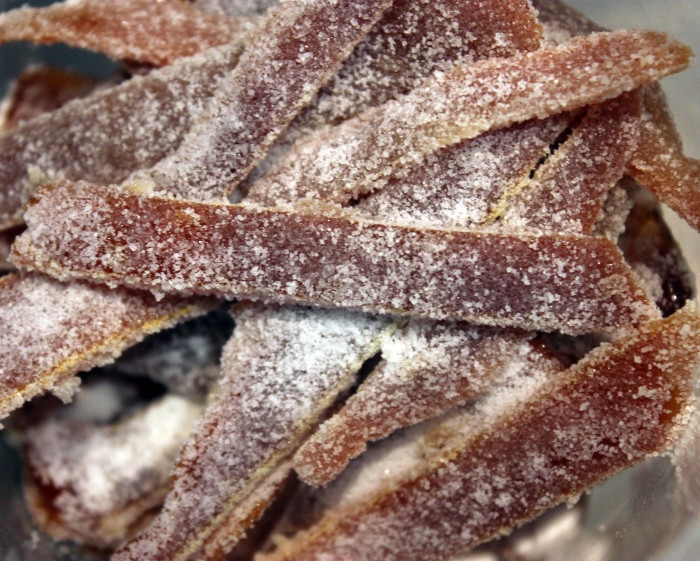One of the major differences between dining at home and in a restaurant is staffing. At home, you are the staff. And you may have a few things on your mind besides the next meal: job, spouse, kids, bills, community issues, the unopened mail on your desk, the unopened emails on your computer. Your life is full.
So, creating a meal means you focus on the “big” parts. Adornments may be an afterthought that cannot be achieved on a given evening.
A restaurant meal is often appreciated because it can be just so complete: big and small things combing into a true food experience. There are those little details: the flowers, the arrangement of silverware, the way the salt and pepper are presented, the little additional pieces that accompany each dish. That staff in the back of the kitchen, busy 12 to 18+ hours a day, includes people who just work the details, the little things that together make the meal richly complete.
I just took the time to make one of those “little things.” These candied orange peels took three days to make, from beginning to end. No I was not working hotly over it every hour, but there was daily work involved to produce one canister of candied orange peels.
What am I going to do with them? Drink garnishes. Topping off the whipped cream that adorns rich gingerbread. Diced and then woven into a salad for texture and flavor. Suzen and I will find ways. And, these critters keep for a year in the freezer or four to up to twelve months in the refrigerator.
How do these slices taste? Sweet and orange, of course. They have little bite to them, a little chew because they are not completely “softened.”
This recipe is from two sources: primarily Southern Italian Desserts by Rosetta Costantino but also The Art of Simple Food II by Alice Waters. You’ll find many recipes candying citrus fruit. I’ve had successes and failures. I turned to these two sources to develop a foolproof — if somewhat lengthy — recipe. In a word, this recipe is a sweet success.
Candied Orange Peels
Yield: about 35 pieces
Ingredients:
- 5 large navel oranges with thick peels
- 4 cups granulated sugar, plus more for coating
- 2 tablespoons fresh lemon juice
- 2 cups water [again, and again, and again]
Preparation:
Use a paring knife to cut the peel from the orange, pith and all, in wide strips running from top to bottom. They will have an elongated diamond shape, about 1 inch at the widest point. [Note, after candying, I cut the final strips into thinner strips about ¼ inch wide as I coated them in sugar].
Put the peels into a large soup pot and cover them generously with cool water. Bring to a boil, boil for 2 minutes, and drain. Repeat the boiling and draining twice more. Return the peels to the pot, cover with cold water until cool enough to handle, then drain.
Lay one strip skin side down on a flat surface and use a paring knife running parallel to the rind to cut away most of the white pith inside, leaving about ⅛ inch of pith along with the peel. Repeat with the remaining strips. (Discard the trimmings.). [Note, you will find this step easy; the pith will be soft, almost spongy, and this is as much a “pushing off” as “cutting” process.]
Return the peels to the pot, cover with cold water, and blanch two more times as before, for a total of five blanchings. Drain the peels and set aside.
Stir the sugar, lemon juice, and water in the pot. Bring to a boil and simmer for 15 minutes to slightly thicken the syrup. Add the peels and cook until they are shiny and translucent, about 1 hour. Do not let the syrup come to a boil, or you may toughen the peels. You want this step to be a simple simmering. Remove the pot from the heat and let the peels plump in the syrup overnight.
Transfer the peels to a wire rack set over a rimmed baking sheet to dry. As you remove each peel from the syrup, run it between your thumb and forefinger to squeeze any excess syrup back into the pot. [Note: that overnight settling may leave you with a very viscous mass; removing the peels will be a chore and they may be heavily coated in goo that does NOT come off with your finger; that will add a day or two to the drying process.]
When the peels are no longer tacky—24 to 48 or more hours later transfer the peels, a few at a time, to a shallow bowl of sugar, tossing to coat them well. Return the peels to the rack to dry overnight.
Transfer the peels to an airtight container with parchment paper separating the layers and store in the freezer, where they will keep for at least a year.
Sources: Southern Italian Desserts by Rosetta Costantino and Jennie Schacht and The Art of Simple Food II by Alice Waters
Photo Information Canon T2i, EFS 60 mm Macro Lens, F/5.6 for 1/60th second at ISO-1600

